1990 VOLKSWAGEN TRANSPORTER page 54
[x] Cancel search: page 54Page 114 of 165
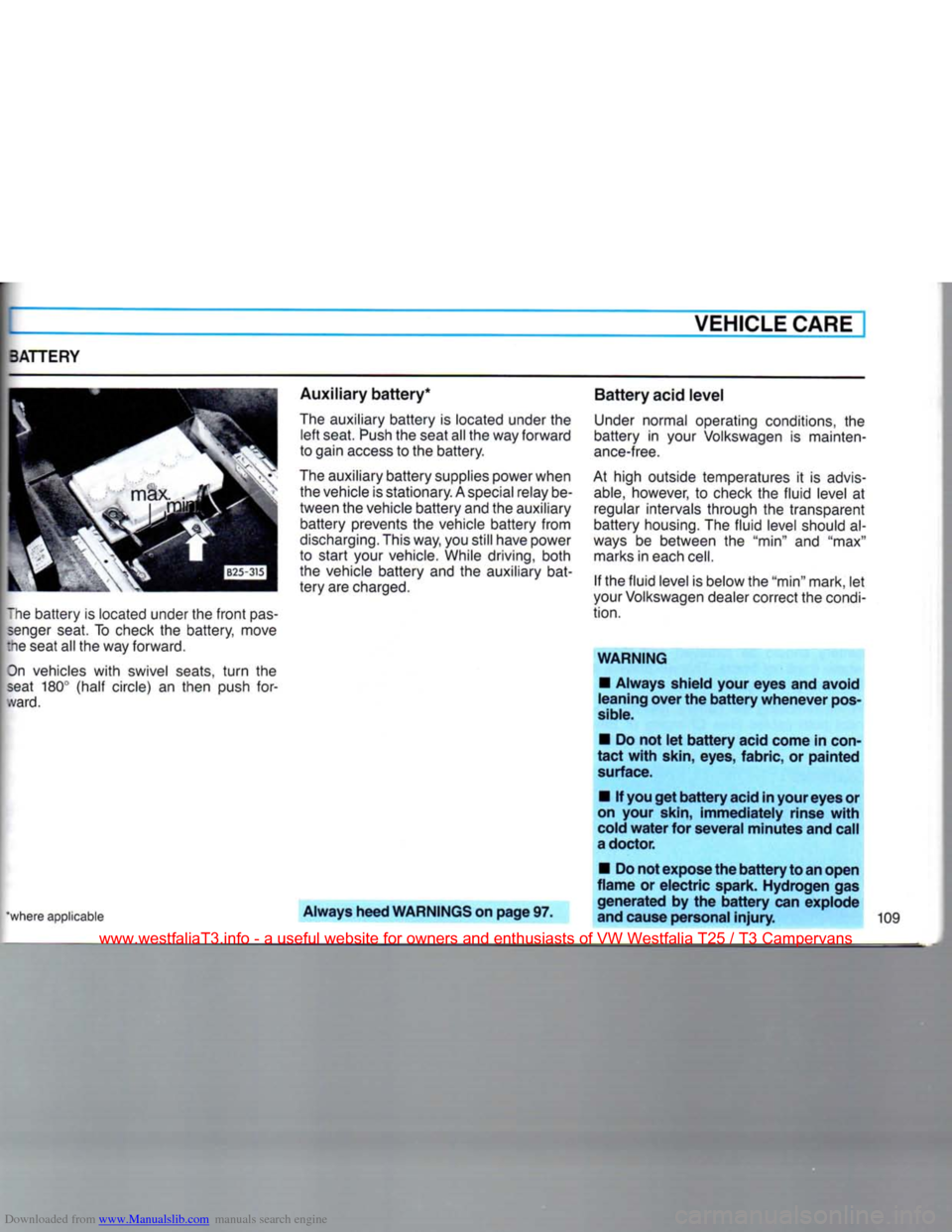
Downloaded from www.Manualslib.com manuals search engine
VEHICLE CARE
3ATTERY
~he battery
is
located under the
front
pas
senger
seat.
To
check
the
battery, move
lie
seat all the way forward.
On
vehicles
with
swivel seats,
turn
the
seat
180°
(half circle)
an
then push
for
ward.
Auxiliary
battery*
The
auxiliary battery
is
located under
the
left
seat.
Push
the
seat all the way forward
to gain
access
to
the battery.
The
auxiliary battery supplies power when the vehicle is stationary.
A
special relay be
tween the vehicle battery and
the
auxiliary battery prevents
the
vehicle battery from
discharging.
This way, you still have power
to start your vehicle. While driving, both
the vehicle battery
and the
auxiliary bat
tery are charged.
'where applicable
Always heed WARNINGS on page 97. Battery acid level
Under
normal operating conditions,
the
battery
in
your Volkswagen
is
mainten
ance-free.
At high outside temperatures
it is
advis
able,
however,
to
check
the
fluid level
at
regular intervals through
the
transparent
battery housing. The fluid level should
al
ways
be
between
the "min" and "max"
marks
in
each
cell.
If
the fluid level
is
below the "min" mark,
let
your Volkswagen dealer correct
the
condi
tion.
WARNING
•
Always shield your eyes and avoid
leaning over the
battery
whenever
pos
sible.
•
Do not let
battery
acid come in
con
tact
with
skin,
eyes, fabric, or painted
surface.
•
If
you
get
battery
acid
in
your eyes or
on
your
skin,
immediately rinse
with
cold
water
for several minutes and call a doctor.
•
Do not expose the
battery
to an open
flame
or electric spark. Hydrogen gas generated by the
battery
can explode
and cause personal injury.
109
www.westfaliaT3.info - a useful website for owners and enthusiasts of VW Westfalia T25 / T3 Campervans
Page 115 of 165
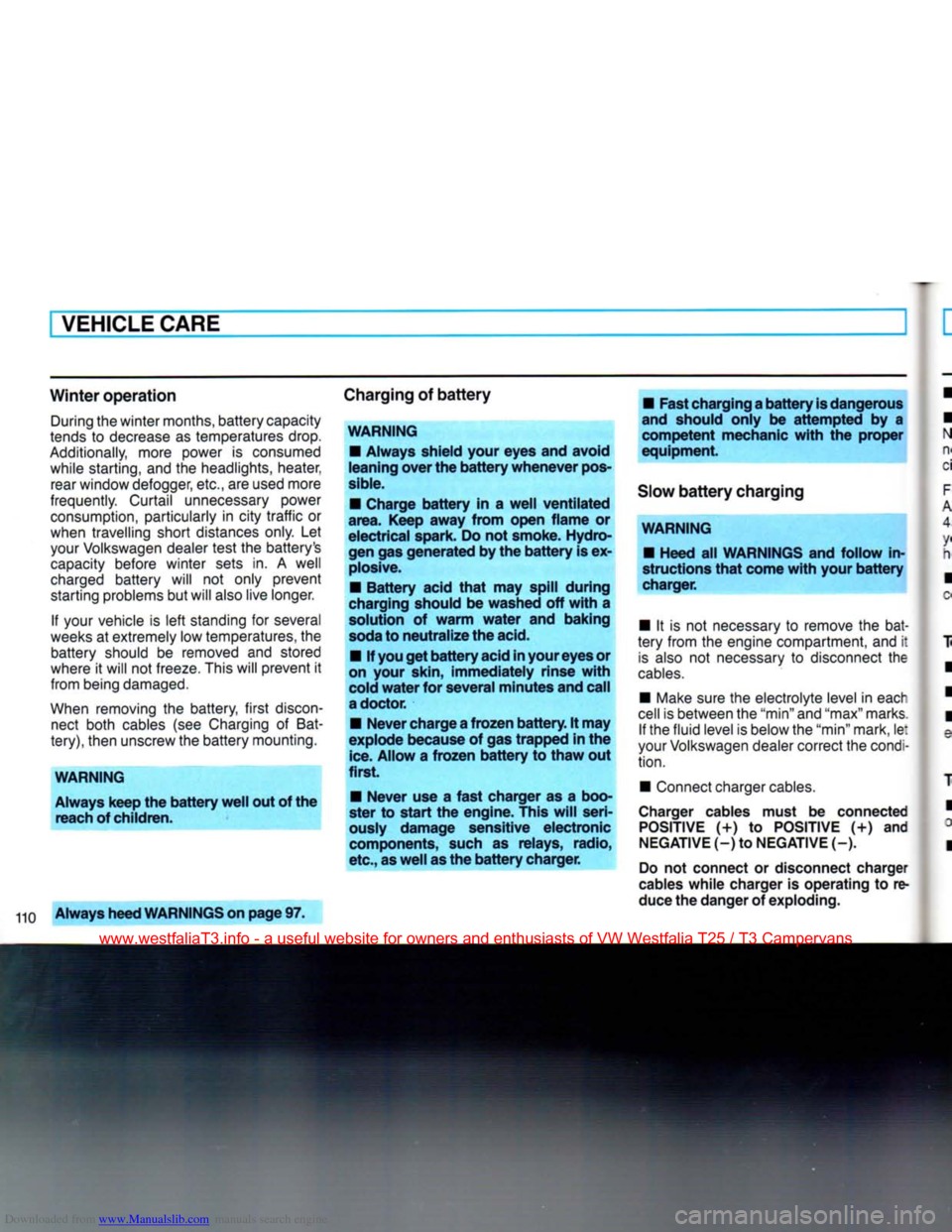
Downloaded from www.Manualslib.com manuals search engine
VEHICLE
CARE
Winter operation During the winter months, battery capacity
tends to decrease as temperatures drop.
Additionally, more power is consumed while starting, and the headlights, heater, rear window defogger, etc., are used more
frequently. Curtail unnecessary power
consumption,
particularly in city traffic or
when travelling short distances only. Let
your
Volkswagen dealer test the battery's
capacity before winter sets in. A well
charged battery will not only prevent
starting
problems but will also live longer.
If
your
vehicle is left standing for several
weeks
at extremely low temperatures, the battery should be removed and stored
where it will not freeze.
This
will prevent it
from being damaged.
When removing the battery, first discon nect both cables (see Charging of Bat
tery),
then unscrew the battery mounting.
WARNING
Always keep the battery well out of the reach of children.
Always heed WARNINGS on page
97.
Charging of battery
WARNING
•
Always shield
your
eyes and avoid
leaning
over
the battery whenever pos
sible.
•
Charge battery in a well ventilated
area.
Keep away from open flame or
electrical
spark. Do not
smoke.
Hydro gen gas generated by the battery is explosive.
•
Battery acid that may spill during
charging should be washed off with a solution of warm water and baking
soda
to neutralize the
acid.
•
If you get battery
acid
in
your
eyes or
on
your
skin,
immediately rinse with
cold
water for several minutes and
call
a
doctor.
•
Never charge
a
frozen battery. It may
explode because of gas trapped in the
ice.
Allow a frozen battery to thaw out
first.
•
Never use a fast charger as a boo
ster to start the engine.
This
will
seri
ously damage sensitive electronic
components,
such as relays, radio,
etc.,
as well as the battery charger.
•
Fast charging
a
battery
is
dangerous
and should only be attempted by a
competent mechanic with the proper
equipment.
Slow battery charging WARNING
•
Heed all WARNINGS and follow in
structions that come with
your
battery
•
It is not necessary to remove the bat
tery
from the engine compartment, and it
is
also not necessary to disconnect the
cables.
•
Make sure the electrolyte level in each
cell
is between the "min" and "max" marks. If the fluid level is below the "min" mark, le:
your
Volkswagen dealer correct the condi
tion.
•
Connect charger cables.
Charger cables must be connected
POSITIVE
(+) to
POSITIVE
(+) and
NEGATIVE
(-) to
NEGATIVE
(-).
Do not connect or disconnect charger
cables
while charger is operating to re
duce the danger of exploding.
www.westfaliaT3.info - a useful website for owners and enthusiasts of VW Westfalia T25 / T3 Campervans
Page 116 of 165
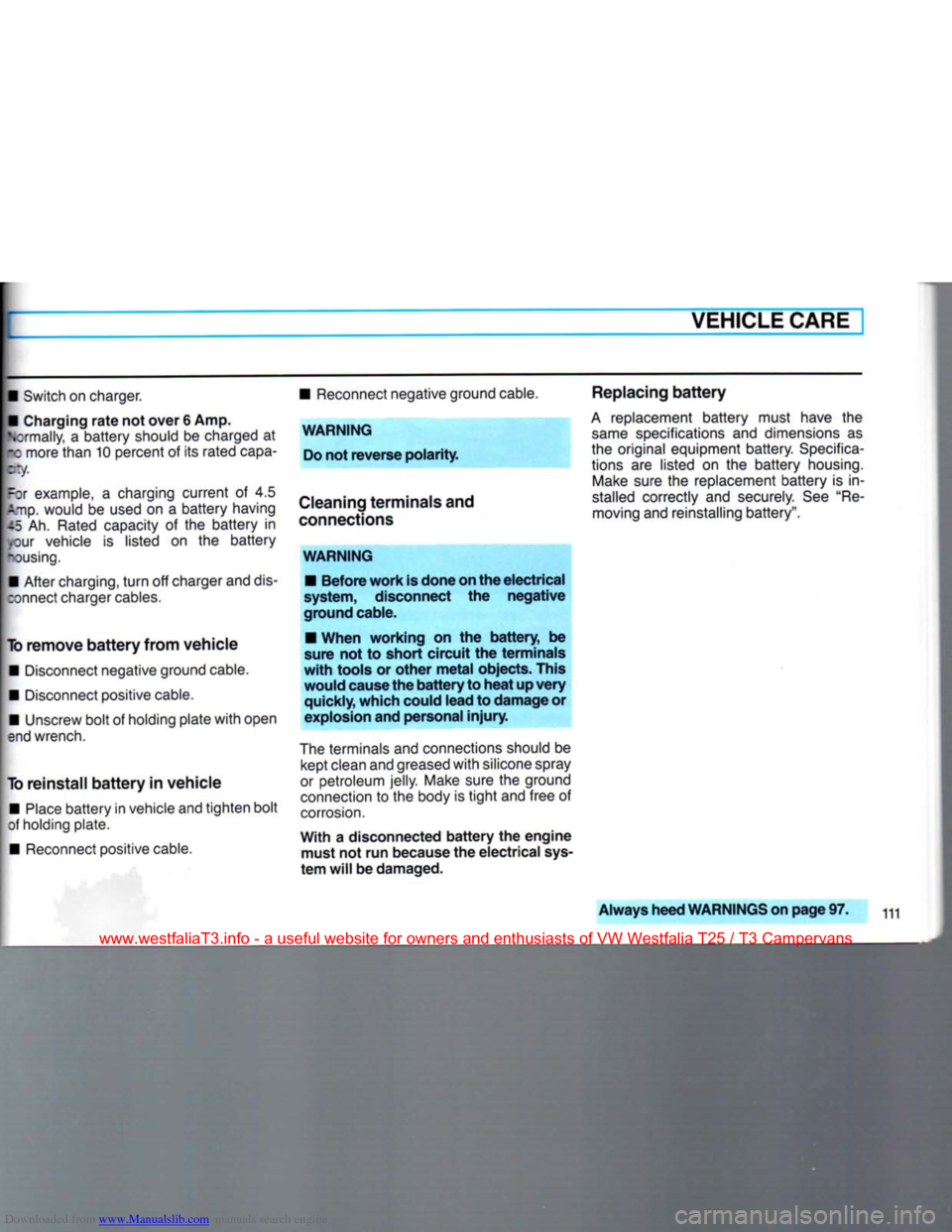
Downloaded from www.Manualslib.com manuals search engine VEHICLE CARE
• Switch on charger.
• Charging
rate
not over 6 Amp.
Vormally,
a battery should be charged at
rc more than 10 percent of its rated
capa
city.
For
example, a charging current of 4.5
Amp.
would be used on a battery having
• Ah. Rated capacity of the battery in .our vehicle is listed on the battery
"Dusing.
• After charging,
turn
off charger and dis-
ronnect charger
cables.
To
remove
battery
from
vehicle • Disconnect negative ground cable.
• Disconnect positive cable.
• Unscrew bolt of holding plate with open
end
wrench.
To
reinstall
battery
in vehicle •
Place
battery in vehicle and tighten bolt
of holding plate.
• Reconnect positive cable. • Reconnect negative ground cable.
WARNING
Do not
reverse
polarity.
Cleaning
terminals
and
connections
WARNING
• Before
work
is done on the
electrical
system, disconnect the
negative
ground cable.
•
When
working
on the
battery,
be
sure not to short circuit the
terminals
with
tools or
other
metal
objects. This
would
cause the
battery
to
heat
up
very
quickly,
which
could
lead
to
damage
or
explosion and personal
injury.
The
terminals and connections should be kept clean and greased with silicone spray
or
petroleum jelly. Make sure the ground
connection
to the body is
tight
and free of
corrosion.
With
a disconnected
battery
the
engine
must
not run because the
electrical
sys
tem
will
be damaged. Replacing
battery
A
replacement battery must have the
same
specifications and dimensions as
the original equipment battery.
Specifica
tions are listed on the battery housing.
Make
sure the replacement battery is in
stalled
correctly and securely. See "Re moving and reinstalling battery".
Always heed
WARNINGS
on
page
97.
www.westfaliaT3.info - a useful website for owners and enthusiasts of VW Westfalia T25 / T3 Campervans
Page 120 of 165
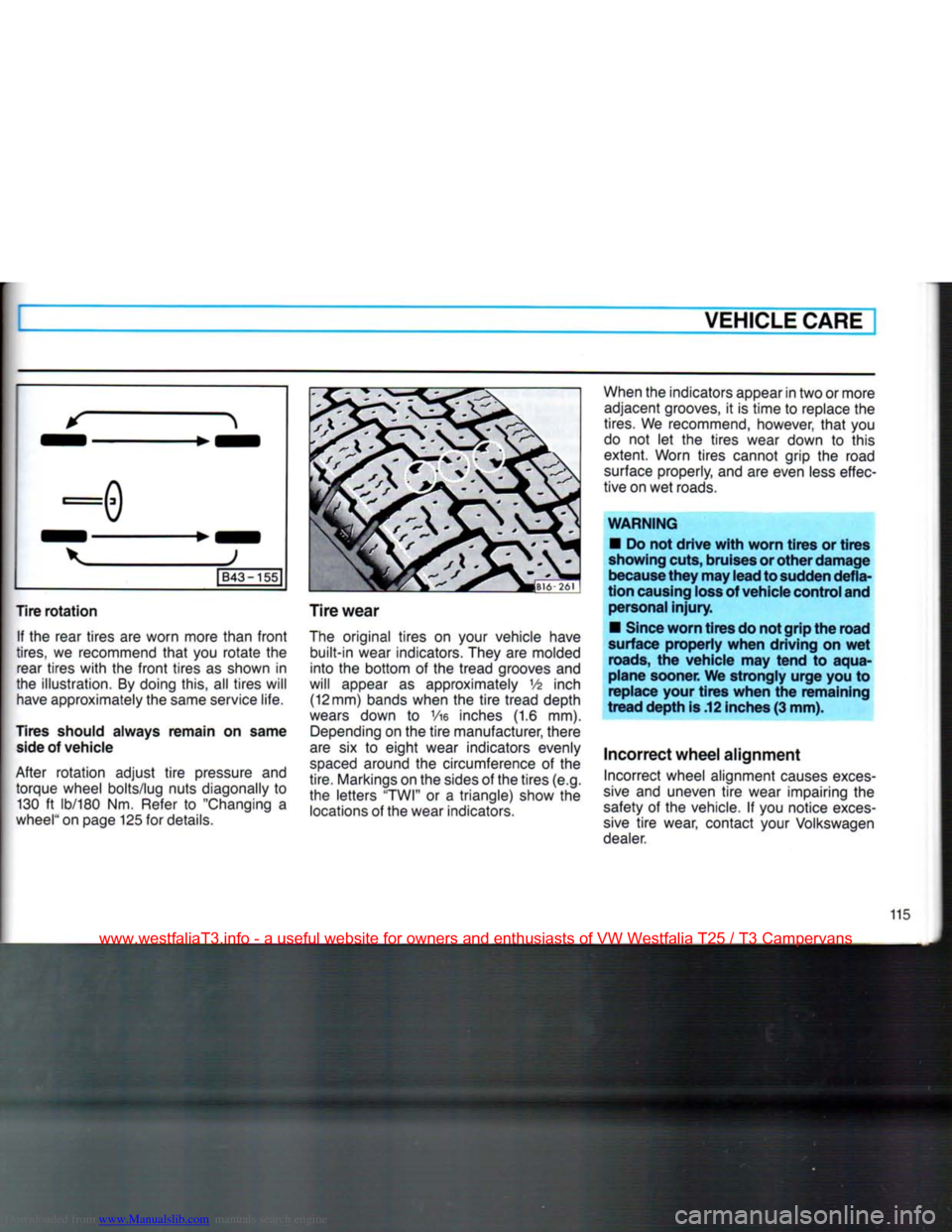
Downloaded from www.Manualslib.com manuals search engine
VEHICLE CARE
K >i
|B43-155|
Tire rotation If the
rear tires
are
worn more than
front
tires,
we
recommend
that
you
rotate
the
rear tires
with
the
front
tires
as
shown
in
the illustration.
By
doing this,
all
tires will
have
approximately the same service life.
Tires
should always remain on same
side
of vehicle
After rotation adjust
tire
pressure
and
torque wheel bolts/lug nuts diagonally
to
130
ft
lb/180
Nm.
Refer
to
"Changing
a
wheel"
on page 125
for
details.
Tire
wear
The
original tires
on
your vehicle have
built-in wear indicators. They
are
molded
into
the
bottom
of the
tread grooves
and
will appear
as
approximately
V6
inch (12 mm) bands when
the
tire
tread depth
wears
down
to Vie
inches
(1.6 mm).
Depending
on the
tire
manufacturer, there
are
six to
eight wear indicators evenly
spaced
around
the
circumference
of the
tire. Markings on the sides
of
the tires (e.g.
the letters "TWI"
or a
triangle) show
the
locations
of
the wear indicators.
When
the indicators appear in two
or
more
adjacent grooves,
it is
time
to
replace
the
tires.
We
recommend, however,
that
you
do
not let the
tires wear down
to
this
extent. Worn tires cannot grip
the
road
surface
properly, and are even
less
effec
tive on wet roads.
WARNING
•
Do not drive
with
worn tires or tires
showing
cuts,
bruises
or other damage
because
they may lead to
sudden
defla
tion
causing
loss
of
vehicle
control
and
personal
injury.
•
Since
worn tires do not grip the road
surface
properly when driving on wet
roads,
the vehicle may tend to aqua
plane sooner. We strongly urge you to
replace your tires when the remaining
tread depth is .12
inches
(3 mm).
Incorrect
wheel
alignment
Incorrect wheel alignment
causes
exces
sive
and
uneven
tire
wear impairing
the
safety
of the
vehicle.
If
you notice
exces
sive
tire
wear, contact your Volkswagen
dealer.
115
www.westfaliaT3.info - a useful website for owners and enthusiasts of VW Westfalia T25 / T3 Campervans
Page 123 of 165
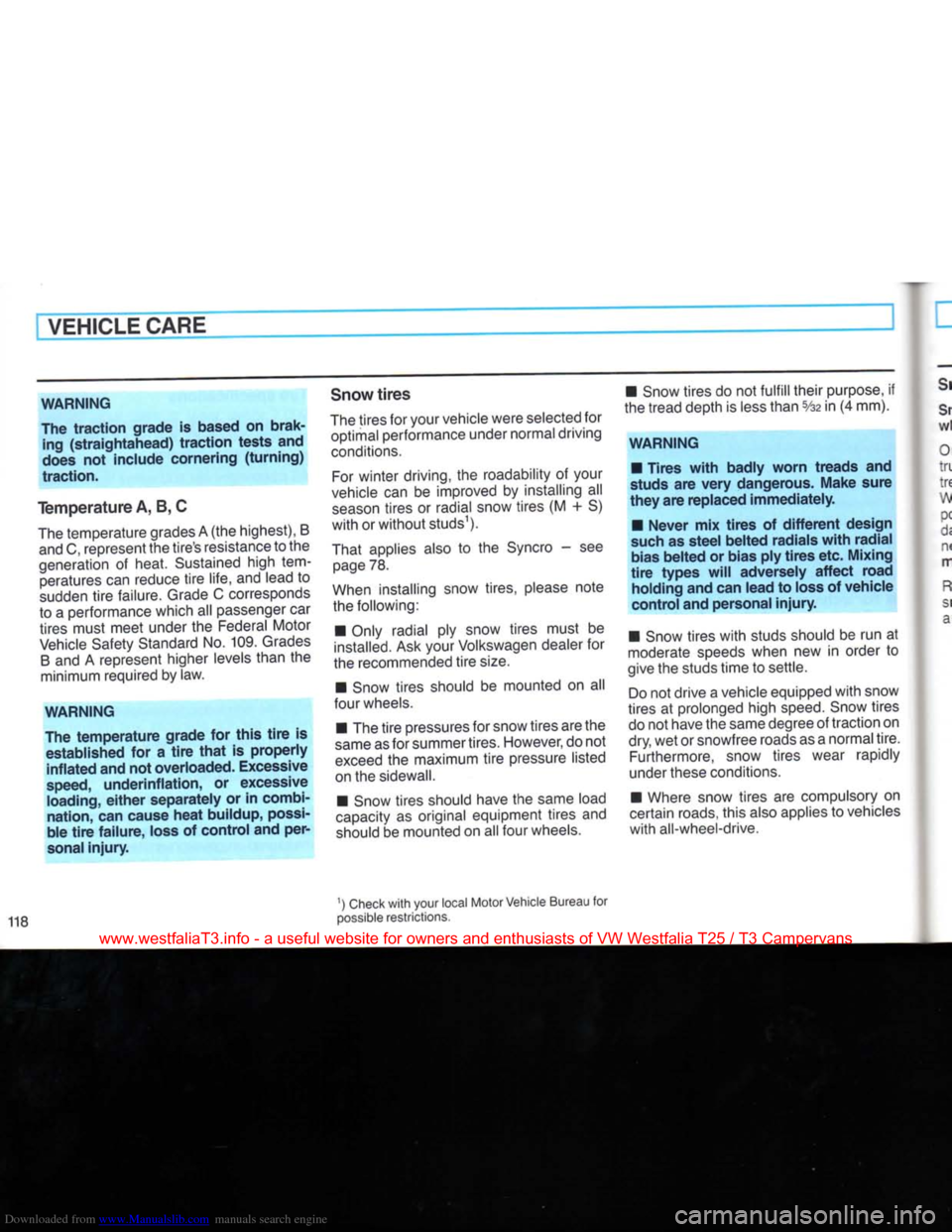
Downloaded from www.Manualslib.com manuals search engine
VEHICLE CARE
WARNING
The
traction
grade
is based on
brak
ing
(straightahead)
traction
tests
and
does not
include
cornering
(turning)
traction.
Temperature
A, B, C
The temperature grades A (the highest), B and C, represent the tire's resistance to the
generation of heat. Sustained high temperatures can reduce
tire
life, and lead to
sudden
tire
failure. Grade C corresponds
to a performance which all passenger car
tires must meet under the Federal Motor
Vehicle
Safety Standard No. 109.
Grades
B
and A represent higher levels than the minimum required by law.
WARNING
The
temperature
grade
for
this
tire
is
established
for a
tire
that
is
properly
inflated
and not
overloaded.
Excessive
speed,
underinflation,
or excessive loading,
either
separately
or in combi
nation,
can cause
heat
buildup,
possi
ble
tire
failure,
loss of
control
and
per
sonal
injury.
Snow
tires
The tires for your vehicle were selected for optimal performance under normal driving
conditions.
For
winter driving, the roadability of your
vehicle can be improved by installing all
season
tires or radial snow tires (M + S)
with
or
without
studs1).
That applies also to the Syncro - see page 78.
When installing snow tires, please note the following:
• Only radial ply snow tires must be
installed.
Ask your Volkswagen dealer for
the recommended
tire
size.
• Snow tires should be mounted on all
four wheels.
• The
tire
pressures for snow tires are the
same
as for summer tires. However, do not
exceed
the maximum
tire
pressure listed
on the sidewalk
• Snow tires should have the same load
capacity as original equipment tires and
should be mounted on all four wheels. • Snow tires do not
fulfill
their purpose, if
the tread depth is
less
than
%2
in (4 mm).
WARNING
•
Tires
with
badly
worn
treads
and
studs are
very
dangerous.
Make
sure
they
are
replaced
immediately.
•
Never
mix
tires
of
different
design
such as
steel
belted
radials
with
radial
bias
belted
or
bias
ply
tires
etc.
Mixing
tire
types
will
adversely
affect
road
holding
and can
lead
to loss of
vehicle
control
and
personal
injury.
• Snow tires
with
studs should be run at
moderate speeds when new in order to
give the studs time to settle.
Do
not drive a vehicle equipped
with
snow
tires at prolonged high
speed.
Snow tires
do not have the same degree of traction on
dry, wet or snowfree roads as a normal tire. Furthermore, snow tires wear rapidly
under these conditions.
• Where snow tires are compulsory on
certain roads, this also applies to vehicles
with
all-wheel-drive.
118 1)
Check
with
your local Motor Vehicle Bureau for
possible
restrictions.
www.westfaliaT3.info - a useful website for owners and enthusiasts of VW Westfalia T25 / T3 Campervans
Page 125 of 165
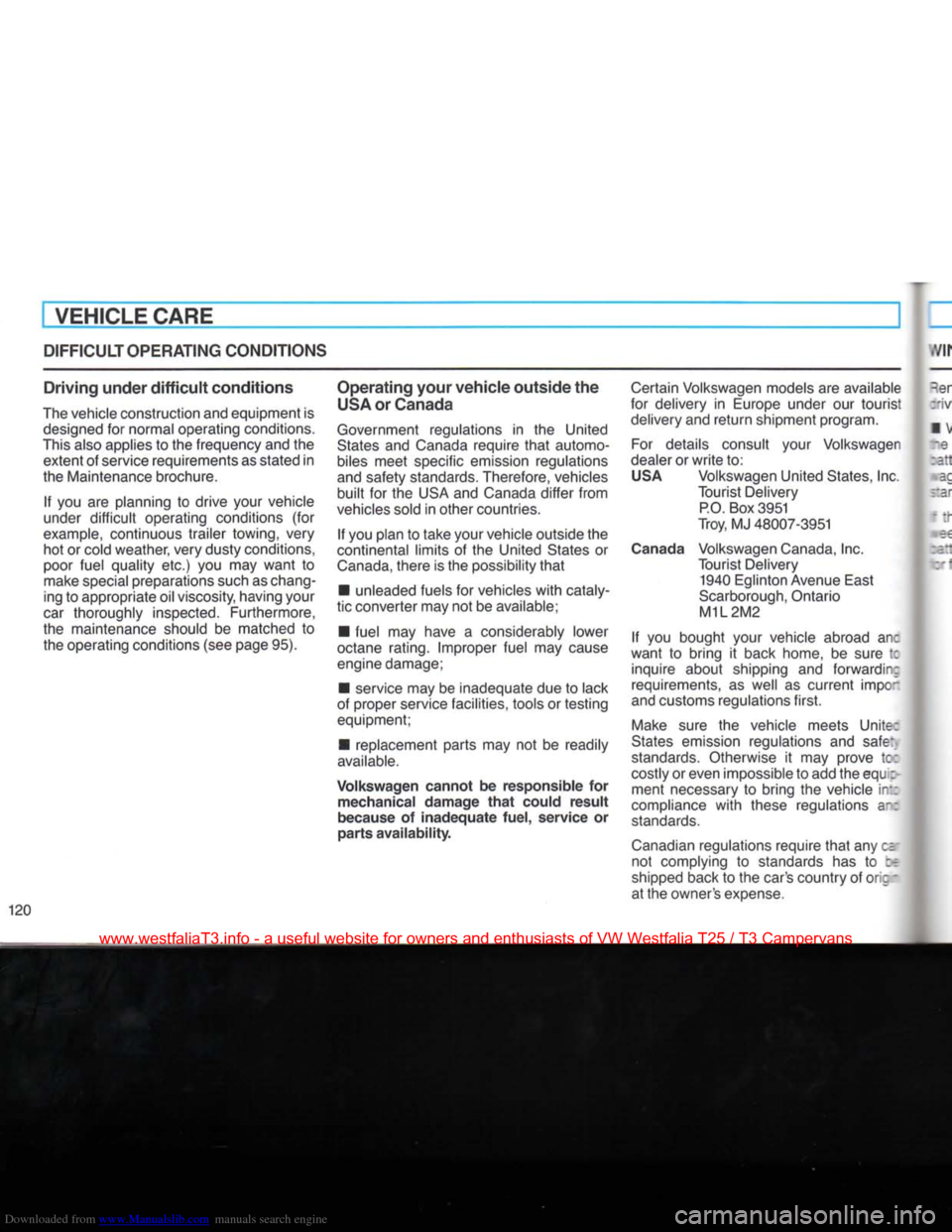
Downloaded from www.Manualslib.com manuals search engine
[VEHICLE
CARE
DIFFICULT
OPERATING
CONDITIONS
Driving
under
difficult
conditions
The
vehicle construction and equipment is
designed
for normal operating conditions.
This
also applies to the frequency and the extent of service requirements as stated in
the Maintenance brochure.
If you are planning to drive your vehicle
under
difficult
operating conditions (for
example,
continuous trailer towing, very hot or cold weather, very dusty conditions,
poor fuel quality etc.) you may
want
to
make
special preparations such as chang
ing to appropriate oil viscosity, having your
car
thoroughly inspected. Furthermore,
the maintenance should be matched to
the operating conditions (see page 95).
Operating
your
vehicle
outside
the
USA
or
Canada
Government
regulations in the United
States
and
Canada
require
that
automo
biles
meet specific emission regulations
and
safety standards. Therefore, vehicles
built
for the USA and
Canada
differ
from
vehicles
sold in other countries.
If you plan to take your vehicle outside the
continental limits of the United States or
Canada,
there is the possibility
that
• unleaded fuels for vehicles
with
cataly
tic converter may not be available;
• fuel may have a considerably lower
octane rating. Improper fuel may cause
engine damage;
• service may be inadequate due to lack
of proper service facilities, tools or testing
equipment;
• replacement parts may not be readily
available.
Volkswagen
cannot be responsible for
mechanical
damage
that
could result
because
of inadequate fuel, service or
parts availability.
Certain
Volkswagen models are available
for delivery in Europe under our
tourist
delivery and
return
shipment program.
For
details consult your Volkswagen
dealer
or
write
to:
USA
Volkswagen United States, Inc. Tourist Delivery
P.O.
Box 3951
Troy, MJ 48007-3951
Canada
Volkswagen
Canada,
Inc. Tourist Delivery 1940 Eglinton Avenue
East
Scarborough,
Ontario
M1L2M2
If you bought your vehicle abroad an:
want
to bring it back home, be sure M inquire about shipping and forwardin:
requirements, as well as current impc
and
customs regulations
first.
Make
sure the vehicle meets Unite:
States
emission regulations and safe:
standards.
Otherwise it may prove tc:
costly
or even impossible to add the eqi : ment necessary to bring the vehicle in::
compliance
with
these regulations a-:
standards.
Canadian
regulations require
that
any c= not complying to standards has to
shipped
back to the car's country of oric -
at the owner's expense.
www.westfaliaT3.info - a useful website for owners and enthusiasts of VW Westfalia T25 / T3 Campervans
Page 126 of 165
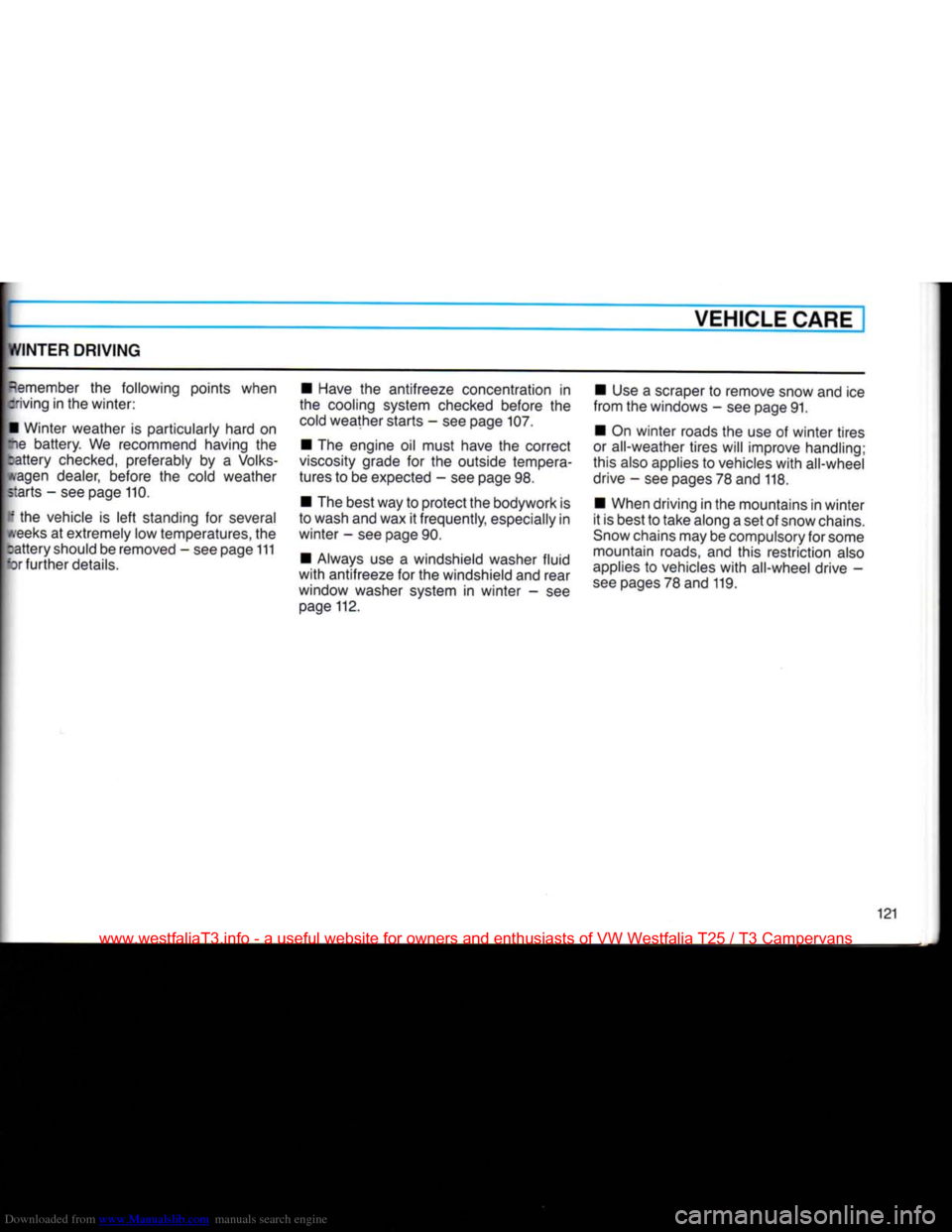
Downloaded from www.Manualslib.com manuals search engine
t'/INTER
DRIVING
VEHICLE CARE
Remember
the following points when
criving in the
winter:
• Winter weather is particularly hard on
ne battery. We recommend having the cattery
checked,
preferably by a
Volks
wagen dealer, before the cold weather starts - see page 110.
If the vehicle is
left
standing for several
iveeks
at extremely low temperatures, the
rattery
should be removed - see page 111
=or
further
details. • Have the antifreeze concentration in
the cooling system checked before the cold weather starts - see page 107.
• The engine oil must have the correct
viscosity grade for the outside tempera
tures to be expected - see page 98.
• The best way to protect the bodywork is
to wash and wax it frequently, especially in
winter - see page 90.
• Always use a windshield washer
fluid
with
antifreeze for the windshield and rear
window washer system in winter - see page 112. • Use a scraper to remove snow and ice
from
the windows - see page 91.
• On winter roads the use of winter tires
or all-weather tires
will
improve handling;
this also applies to vehicles
with
all-wheel
drive - see pages 78 and 118.
• When driving in the mountains in winter
it is best to take along a set of snow chains.
Snow
chains may be compulsory for some
mountain roads, and this restriction also
applies
to vehicles
with
all-wheel drive -
see
pages 78 and 119.
121
www.westfaliaT3.info - a useful website for owners and enthusiasts of VW Westfalia T25 / T3 Campervans
Page 133 of 165
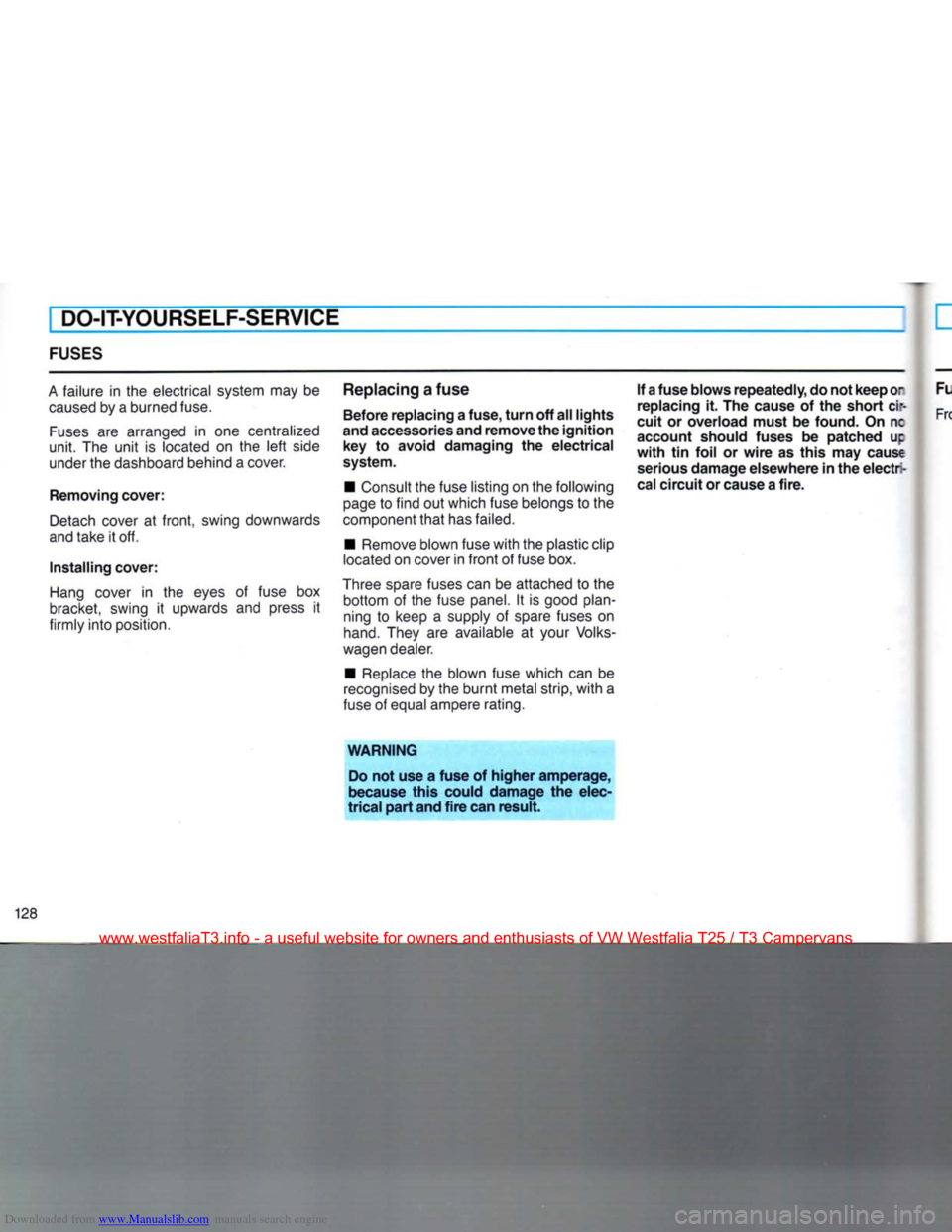
Downloaded from www.Manualslib.com manuals search engine
DO-IT-YOURSELF-SERVICE
FUSES
A
failure in the electrical system may be
caused
by a burned fuse.
Fuses
are arranged in one centralized
unit.
The
unit
is located on the
left
side under the dashboard behind a cover.
Removing
cover:
Detach cover at
front,
swing downwards
and take it off.
Installing
cover:
Hang
cover in the eyes of fuse box
bracket, swing it upwards and press it
firmly
into
position.
Replacing
a
fuse
Before
replacing
a fuse,
turn
off all
lights
and accessories and
remove
the
ignition
key to
avoid
damaging
the
electrical
system.
• Consult the fuse listing on the following
page to
find
out which fuse belongs to the
component
that
has failed.
• Remove blown fuse
with
the plastic clip
located on cover in
front
of fuse box.
Three spare fuses can be attached to the
bottom
of the fuse panel. It is good planning to keep a supply of spare fuses on
hand.
They are available at your Volks
wagen dealer.
• Replace the blown fuse which can be
recognised by the
burnt
metal strip,
with
a
fuse of equal ampere rating. If a
fuse
blows
repeatedly,
do not
keep
or
replacing
it. The cause of the
short
cir
cuit
or
overload
must
be found. On nc
account
should fuses be
patched
up
with
tin
foil
or
wire
as
this
may cause serious
damage
elsewhere
in the
electrj
cal
circuit
or cause a
fire.
WARNING
Do not use a
fuse
of
higher
amperage,
because
this
could
damage
the
elec
trical
part
and
fire
can
result.
128
www.westfaliaT3.info - a useful website for owners and enthusiasts of VW Westfalia T25 / T3 Campervans